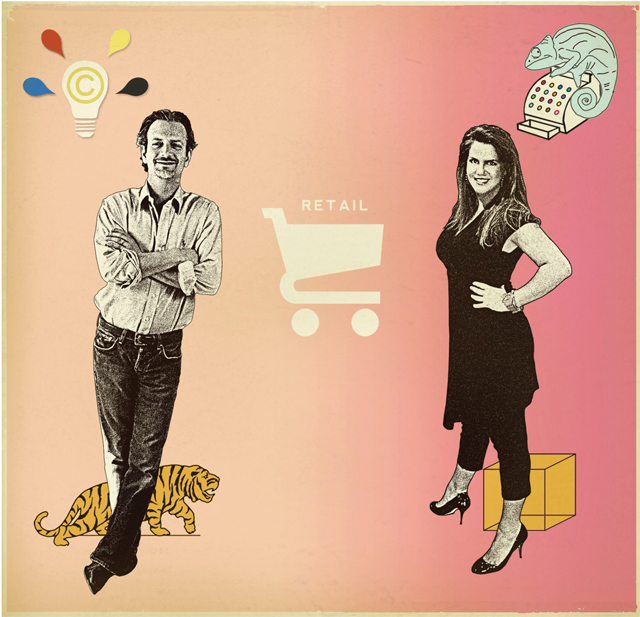
Rick Barrack
Chief Creative Officer, CBX |
Rachel Shechtman
Founder, Story |
|
The dialoguers: Rachel Shechtman is the founder of
Story, a Manhattan boutique that updates its theme--and products!--every
four to eight weeks. Rick Barrack is the chief creative officer at
branding firm CBX, which recently helped Duane Reade do the impossible:
execute a redesign to become cool (at least, as much as any drugstore
can be cool) . SHECHTMAN: When we think of the next generation of retail design, we think about storytelling. My rule: 70% of an experience should be what consumers know and 30% should be surprise and delight. What you did with Duane Reade's package design is all delight. Take a pretzel, for example. Everyone knows what it is, and there's not much product differentiation. But you put it in a bag with black-and-white stripes that look like the Empire State Building, and suddenly consumers think, Oh my God, this is so cool. BARRACK: It creates an engagement opportunity. Our models to create that engagement are really the same in many ways; we're just doing it on a much more mass scale. SHECHTMAN: Why are people going to brick and mortars at all? For the experience. BARRACK: The dynamics of e-commerce, as it has evolved, created a new shopping behavior. People demand more information. And now, outside of e-commerce, we have to provide that as well. SHECHTMAN: So many e-commerce brands have just been nailing it, and a lot of brick-and-mortar retailers got lazy. Now the older sibling is looking up to the younger sibling. BARRACK: Well, e-commerce has provided exclusivity, and people want that in retail stores. Duane Reade narrowed offerings to make it feel more relevant--and exclusive--to New Yorkers: At the Wall Street location, the sushi bar is called Up Market and there's a stock ticker; in Williamsburg, there's a growler bar. It's telling the consumer, We understand the way you live, where you live, and what you need from us. SHECHTMAN: Consumers also want to know the retailer's point of view. My store is like a magazine: There's the editorial side and the publishing side, as we partner with brands for sponsorship. We have to let our story drive the assortment, rather than let the assortment drive our story. And when that story is sincere, it will spread just like a viral video, attracting all demographics, from 9-year-old Bella, who lives up the street, to my 65-year-old neighbor. BARRACK: You have to walk in the shoes of consumers. When we start working with a brand, we ask, If this brand were a room, what would it look like? And then we'll build multisensual rooms to get a better sense of the product and its consumer. SHECHTMAN: It's funny you say, "What would this brand look like?" I do a retail-experience test--walk out of a store and describe it as if it were someone you met at a cocktail party. BARRACK: That's right. It's not rocket science. You have got to step out of your own skin and spend time there. We'll take clients on daylong expeditions to show them more interesting retail spaces--even if it's for package design--to get inspiration. We'll even take them to the local gym so they get a sense of the look of the community. It's a journey. You can't turn up the heat on a cake and expect it to taste the same. Good ideas need time to bake. SHECHTMAN: It's really about using storytelling as a matchmaker between brands and consumers. And design is a big part of that. You're saying, "Hey, we're cool," without really saying it. | |
No comments:
Post a Comment